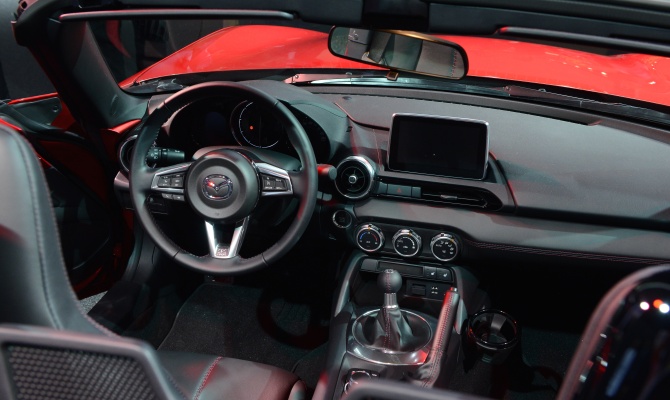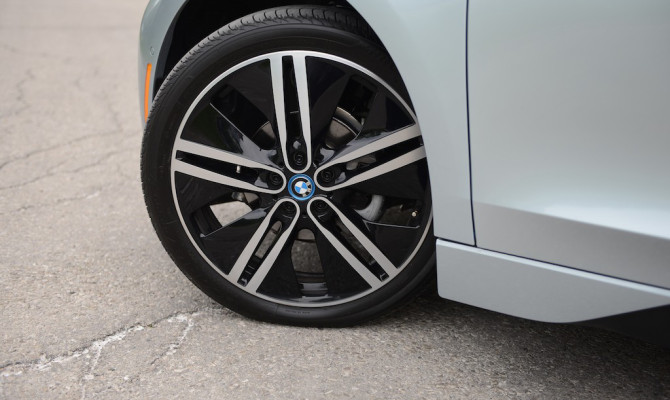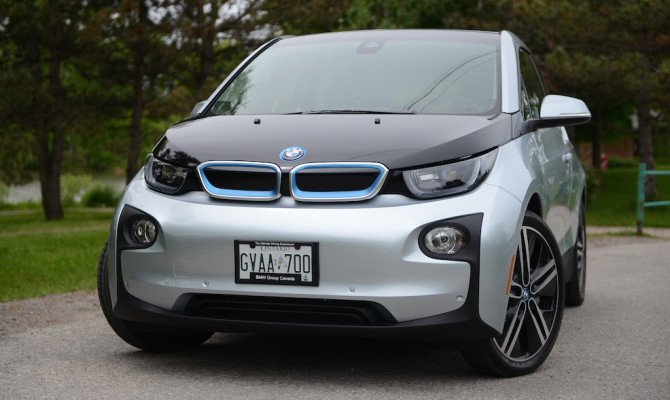“The all-new Volt delivers a total driving range of up to 675 kilometres.”
LOS ANGELES, California.
The new generation 2016 Chevrolet Volt has been awarded Green Car of the Year award from Green Car Journal at the Los Angeles Auto Show.
This is the second time the Volt has won the award, the first time being when it debuted in 2010 as a 2011 model. Green Car Journal praised the Volt’s increased range, all-new propulsion system and bold design.
“Chevrolet’s all-new Volt is a milestone, building on an already-technologically advanced ‘green’ car and delivering what buyers have longed for, including an impressive 53-mile (85 kms) driving range on a single charge,” said Ron Cogan, editor and publisher of Green Car Journal and CarsOfChange.com.
“A visually appealing design, increased five-passenger seating, and an array of on-board electronics combine with the Volt’s inherent efficiencies to make the 2016 Chevrolet Volt a real winner,” Cogan said.
The all-new Volt delivers a total driving range of up to 675 kilometres. Combined with EPA-estimated fuel economy of 5.6 L/100kms highway, Chevrolet expects owners to travel 1,600 kilometres between gasoline fill-ups.
“Chevrolet is all about bringing affordable electrification to our customers, and that is exactly what we did with the Volt” said Steve Majoros, Chevrolet marketing director. “For Volt to stand out in Green Car’s evaluation, it reaffirms Chevrolet’s commitment to being a leader in electrification.”
According to independent surveys, Volt owners are the most satisfied in the industry, and 70 percent of those owners are new to General Motors.
The Green Car of the Year award is determined by an 11-member panel, and is based on fuel efficiency, Environmental Protection Agency and California Air Resources Board certifications, performance and affordability. The other finalists were the Audi A3 e-tron, Honda Civic, Hyundai Sonata and Toyota Prius.
The 2015 model year vehicles are rolling into dealerships, with just a few stragglers set for later arrival in the New Year. (more…)
Electric car buyers need to know if they can live with the limits of the electric cars’ range or if they want the flexibility to extend the range with an on-board generator…
This story could be obsolete in a month as automakers add electrification to existing models and introduce all new models, at an incredible rate.
The market for electric cars or plug-in hybrids is very small but it’s growing. The success of Tesla’s Model S has shot its stock price into the stratosphere, as investors bet on that company’s emergence as the electric car and technology leader. The stock price should really reflect the cars sold, as Tesla can only make about 20,000-25,000 cars annually for a worldwide market.
The Market
Green Car Report recently published a sales report on all electrics sold in Canada for the first six months of the year. The list of vehicles sold is compiled from companies’ self-reporting but Ford’s data is missing. This Green Car Report estimates that Ford’s numbers will push overall electric sales to 2,200 for the first half of the year, a 50 per cent improvement over a year ago. What we do get is a good snapshot of the market. With only 1,941 electrics officially counted, amounts to only 0.21 per cent of the overall Canadian marketplace. (Canadians are on track to buy almost 1.7 million vehicles this year.) So these are tiny but important numbers and the trend is higher. The clear winner isn’t the Tesla at all; in fact it is in third place behind the Chevy Volt and Nissan LEAF. Chevy sold 831 Volts up to July with Nissan selling 462 LEAFs and Tesla moving 290 Model S cars. The Smart Full Electric Drive comes in fourth with 163 cars sold and in its first month of sales (June) the BMW i3 looks good with 50 units sold.
Not all electric cars are the same
What many people don’t realize is the complexity of the electric car market. I look at it this way, if the car can be plugged into an outlet; it is at least partially electrified. There are pure electric cars like the Nissan LEAF, Tesla Model S, Smart Electric, Mitsubishi i-MiEV and BMW’s new i3 – all of these use just electricity to propel the car. Then there are electric cars that have an onboard generator, should the range of the electric pack limit driver’s intentions. The Chevy Volt, Cadillac ELR, the Toyota Prius Plug-In and the BMW i3 are, or can be equipped, with a gasoline engine to either drive the wheels or charge the battery. This is one area where the Chevy Volt wins. With roughly a 65 km range on pure electricity and a small generator on board to extend the range indefinitely, this car makes a lot of sense. This is why the BMW i3 has an optional generator for $3,000 to extend the range of that model. But if the buyer chooses this option, the range of pure electric drive is limited because of the added weight of the car. Electric car buyers need to know if they can live with the limits of the electric cars range or want the flexibility to extend the range with an on-board generator.
What is still to come?
We are living in interesting times.
More and more electric cars are being added, not to meet the demand but to meet regulatory requirements. For the model year 2016, the United States has a new cooperate average fuel economy (CAFE) standard that has each manufacturer trying to hit 35.5 mpg average across their fleet, including small trucks. This isn’t doable with the current internal combustion engine technology, so these manufacturers are looking to electrification as the answer. Even though more and more electric versions will arrive, don’t expect them to sell. In fact, most car companies don’t expect them to sell at all; they just want the mpg credit towards the new regulations. This might sound cynical but watch how many electric cars will arrive, especially for the 2016 model year, and how many you will actually see on the road. Most are built at a loss, to offset thirstier, gas-loving machines.
Verdict
Even though electric car sales are very small and many new models will go unnoticed, the trend to electrification is here. With markets like China mandating a percentage of electric cars to offset its horrific pollution, will help move the numbers of electric vehicles worldwide. This, along with steady adoption rates here in North America will help promote better charging infrastructure. Another factor is the price to own an electric car. The Smart Electric is priced at $27,000 making it the least expensive full electric car. With Nissan hacking its price on the LEAF to just over $31,000 and the Volt starting at roughly $35,000, these cars are more affordable than ever. I think the BMW i3 is very attractive for $45,000 because it is a luxury brand at an attainable price. The real showstopper will be the Tesla Model III that they hope to sell for US$35,000 with more than 400km of electric range when it is introduced in 2017.
Even though Tesla has the sex appeal going right now, don’t count out the other mainstream manufacturers with decades, if not centuries of auto making knowhow, to take on the challenge.
Hybrid vehicles have never been more affordable and certainly well worth consideration, if you’re thinking about buying a new vehicle…
Tesla CEO Elon Musk recently equated hybrid vehicles to early amphibians that hopped out of the oceans, learned to survive on land and eventually disappeared.
Ironically, if the electric vehicle (EV) evolved in a similar way, Tesla (an exclusively EV company) wouldn’t exist right now and this would probably be in a vibrant Hybrid Age!
Despite the early birth of production EV, hybrid (HEV) and now plug-in hybrid electric vehicle (PHEV) sales continue to rise, new models continue to arrive and at least three all-new PHEVs are expected later this year.
A HEV functions just like, or similar to, a conventional gas-engine vehicle from a driver/owner perspective. It consumes substantially less fuel, especially in an urban environment, and a regenerative braking system can greatly extend the life of brake friction pads.
A PHEV increases the energy saving, money saving, and greenhouse gas reducing advantages by tapping into an electrical source and pulling relatively inexpensive electrical power off the main grid. It then uses this energy to go further on electrical power alone. How far depends primarily on the capacity (size) of its storage battery, but also on the drive system, the terrain and weather conditions and how the PHEV is driven.
Lugging around a bigger battery obviously increases the weight of a PHEV and it takes up either passenger cabin or more likely trunk cargo space. The latest lithium-ion battery packs are lighter and more compact, but the space sacrifice is something that a prospective owner must be willing to live with.
Hybrid owner feedback is generally very positive and the fuel savings can be substantial. That said, you generally pay a premium for this technology, but that gap is rapidly narrowing. Last year, GM slashed $5,000 off the price of its popular Chevrolet Volt, the best selling PHEV on the market. While GM marketing promotes the Volt as an “extended range” electric vehicle, as its road wheels are always driven by an electric motor, it’s still classified as a PHEV. A small on-board gas engine generates electricity, when necessary.
The new Honda Accord Hybrid (a HEV) further blurs the differences between HEV and PHEV, as it uses the same two-motor powertrain used in the Accord Plug-in Hybrid (a PHEV edition that’s currently only sold in selected markets). At speeds under 80 km/h the road wheels are driven by an electric motor and its Atkinson cycle gas engine is only used to generate electrical power, when needed.
The current list price for an Accord EX-L is $29,455 and the Accord Hybrid starts at $29,590, which is only $135 more. The top-line Accord Touring V6 sells for $35,400 and the Touring edition of Accord Hybrid is $36,690, just an extra $290. The price differential is almost non-existent.
Choosing HEV or PHEV boils-down to whether an owner can take full advantage of the plug-in electrical storage feature and normal driving commutes are within the electric-only speed and distance range of the PHEV. A low-speed urban driving commute allowing the PHEV to be charged at home overnight and topped-up again while at work, during the day, would be an ideal scenario.
While the popularity of hybrid vehicles continues to grow, barring a sudden spike in the price of oil/gasoline, a meteoric rise in the popularity of alternatives to the old reliable gas engine vehicle is unlikely. Then again, who knows what the future, or the next twist in evolution, will bring. Hybrid vehicles have never been more affordable and certainly well worth consideration, if you’re thinking about buying a new vehicle.
Recent Comments
- { Enjoyed your Forest of Bowland in the BMW X5M, particularly the photo of the BMW in front of the main part of Stonyhurst College where... }
- { Bantam designed the Jeep, not Willy's or Ford. The American military gave the original Bantam prototype to Willys and Ford to copy. There is plenty... }
- { All Escalades come with a 6.2-lilter V8 engine that produces 420 horsepower. A six-speed automatic is the only transmission offered and drives the rear wheels.... }
- { Alexandra is an excellent journalist. }
Popular Posts
- Journey to a ‘Sparkling’ Luxury Okanagan Resort “Four lucky readers will put a Dodge Journey’s weekend-...
- The Need For Speed: Hike Those Highway Limits More than half of those polled believe the province sho...
- Drives-U-Crazy… Erratic drivers. An early morning drive from Kelowna to Vancouver is nor...
- Readers Respond: The Pros and Cons of Increasing B.C. Speed Limits Increasing the speed limits will only increase risk to...
- Honda CR-V Review: The Compact Crossover To Get Things Done The CRV is a very stylish and aerodynamic crossover veh...

























